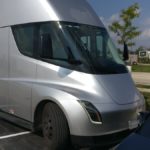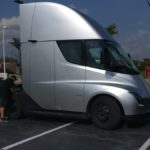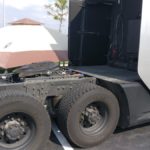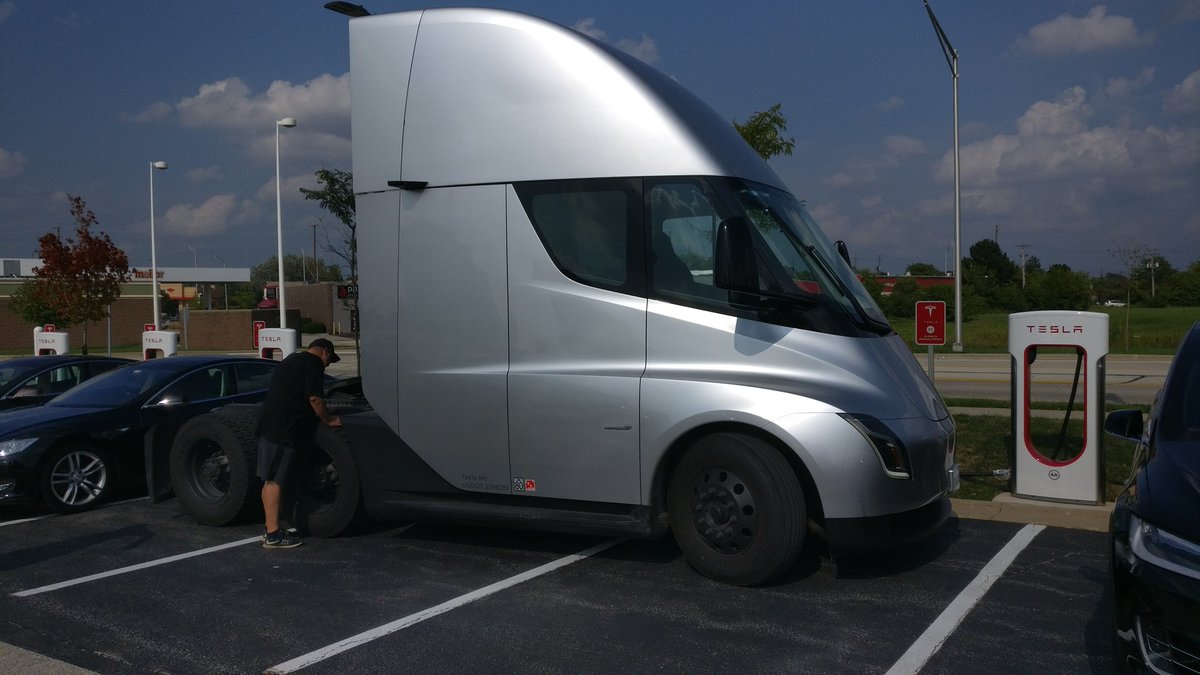
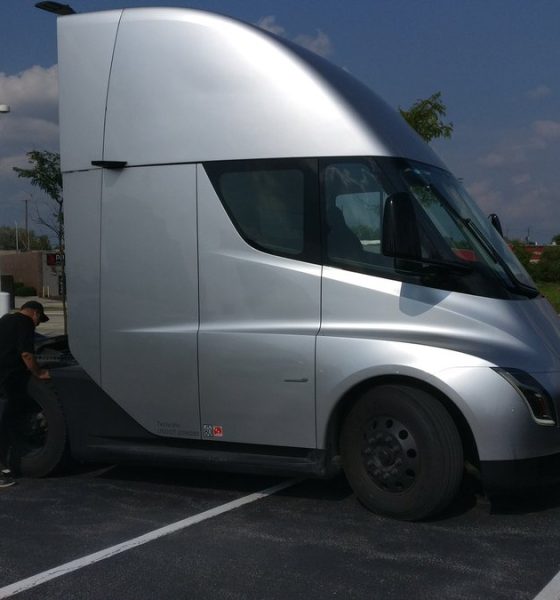
News
Tesla Semi’s strong demand could expedite the release of the pickup truck
The all-electric Semi truck could very well be the most disruptive vehicle in Tesla’s lineup. Since its unveiling, the Tesla Semi has garnered reservations from some of the United States’ most prominent businesses like FedEx and PepsiCo. During the Q1 2018 earnings call back in May, Elon Musk and CTO JB Straubel noted that the company had received around 2,000 pre-orders for the vehicle.
Some of the trucking market’s veterans remain skeptical of the Semi. A spokesman for Cummins Inc., one of America’s premier engine-makers, recently stated that they do not see all-electric trucks like the Semi being viable alternatives to diesel-powered long-haulers anytime soon. Allen Schaeffer, executive director of the Diesel Technology Forum trade group, also expressed doubt on Elon Musk’s claims that the Semi would be cheaper to run and operate than its diesel-powered counterparts.
Regardless of these doubts, Tesla is pushing on with the development of the electric truck, with Elon Musk stating during the Q2 2018 earnings call that the company has made significant improvements to the Semi since it was unveiled last November. The Semi’s customers also appear to be completely on board with their adoption of the all-electric trucks. Earlier this year, it was even announced that some of the Semi’s biggest customers such as PepsiCo and Anheuser-Busch are working with Tesla to develop and install a network of in-house charging stations for the upcoming vehicle. These stations would be spaced close enough to ensure that the trucks would be able to traverse their routes without any range issues.
- The Tesla Semi spotted in Chicago. [Credit: Rec1pr0city/Twitter]
- The Tesla Semi spotted in Chicago. [Credit: Rec1pr0city/Twitter]
- The Tesla Semi spotted in Chicago. [Credit: Rec1pr0city/Twitter]
The Tesla Semi sighted at Chicago’s Rolling Meadows Supercharger. [Credit: Rec1pr0city/Twitter]
Just recently, the Semi visited yet another customer. This time, the all-electric truck traveled to trucking giant J.B. Hunt’s headquarters in Arkansas, where it was showcased to the company’s employees. Just like the truck’s visit to PepsiCo’s Texas facility earlier this year, employees of the trucking company were able to get up close and personal with the vehicle. Social media posts from individuals in attendance during the Semi’s visit show that J.B. Hunt’s employees, contrary to being skeptical of the vehicle, appear to be excited about the electric truck. Tesla critics would find it difficult to dismiss J.B. Hunt’s authority in the trucking industry as well, considering that the company has been in the transport industry for more than 50 years, and that its current fleet is comprised of over 12,000 trucks and 100,000 trailers and containers.
This strong, positive reaction from America’s premier hauling companies bodes well for the Semi. It remains to be known how many reservations Tesla currently has for the vehicle, but there’s a very good chance the pre-order list is significantly longer than 2,000 units today. That said, the anticipation surrounding the Semi might result in the release of one of Tesla’s most highly-anticipated vehicles to be expedited.
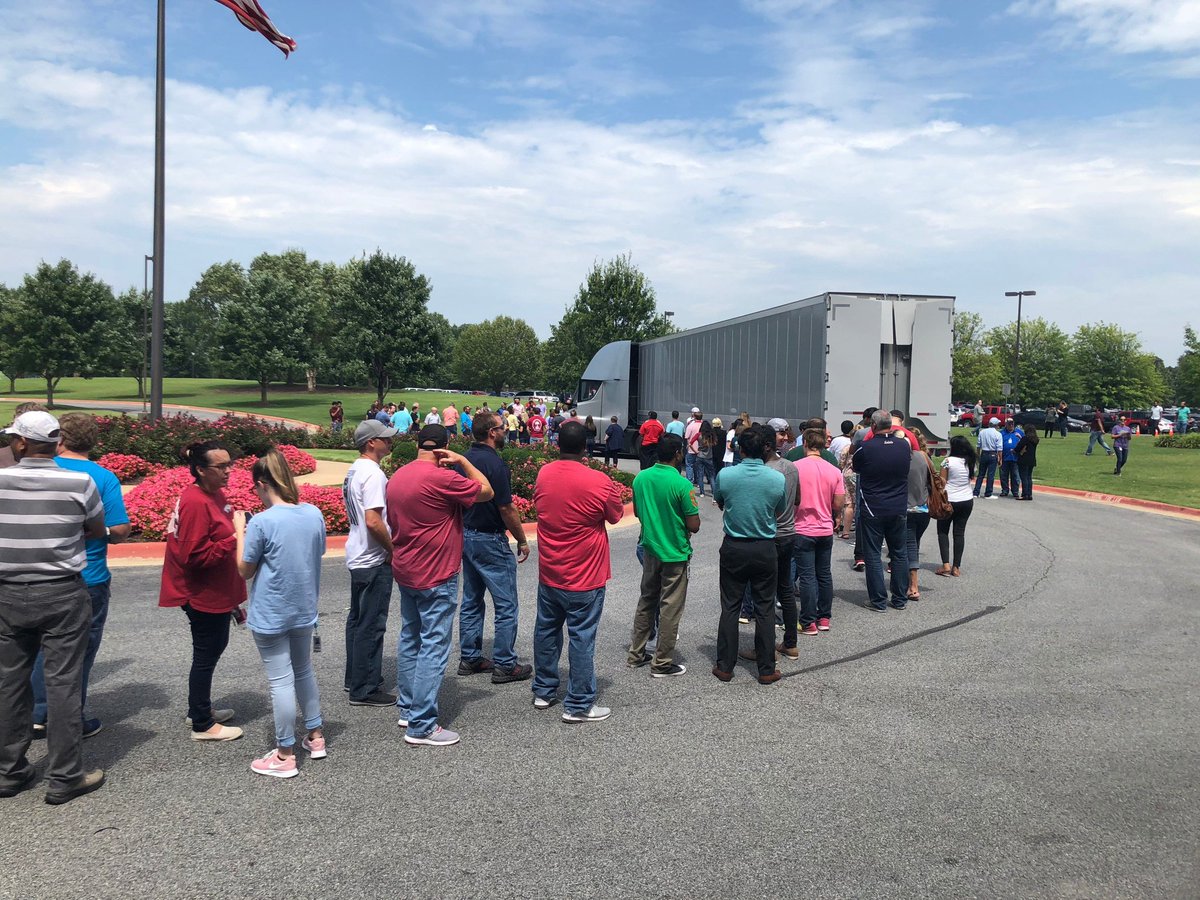
Elon Musk was present on Twitter during the weekend, and while interacting with his followers, Musk noted that the electric car company may be able to release the Tesla pickup truck earlier than expected. Initial expectations point to the Tesla Truck being released sometime after the Model Y is unveiled. Considering that the Model Y is expected to be unveiled sometime in 2019, there is a fair chance that the Tesla Truck’s official unveiling would be scheduled for 2020 at the earliest.
Maybe …
— Elon Musk (@elonmusk) August 25, 2018
Elon Musk did note last year that he is thinking of making the Tesla Truck a smaller version of the Semi. This means that Tesla would likely be carrying over some of the Semi’s elements to the pickup truck. Since the Semi already shares components with the Model 3, such as its powertrain, doors, and air vent design, it seems safe to assume that Tesla is planning on using the Model 3 as a template for the pickup truck as well. This is a strategic move for Tesla, since by the time it starts producing the Semi and the Tesla Truck, everything connected to the Model 3 and its components would likely have been smoothed out by the company.
Thanks to the lessons the company learned from the Model 3, the Semi (as well as the Model Y, which is also expected to be based on the Model 3) might very well see a less troublesome rollout. If Tesla manages to pull this off, it could provide an opportunity for Tesla to bring the pickup truck to market sooner. If that happens, Elon Musk’s tweet about an earlier release for the Tesla Truck could very well prove accurate.

Elon Musk
Elon Musk’s X will start using a Tesla-like software update strategy
The initiative seems designed to accelerate updates to the social media platform, while maintaining maximum transparency.

Elon Musk’s social media platform X will adopt a Tesla-esque approach to software updates for its algorithm.
The initiative seems designed to accelerate updates to the social media platform, while maintaining maximum transparency.
X’s updates to its updates
As per Musk in a post on X, the social media company will be making a new algorithm to determine what organic and advertising posts are recommended to users. These updates would then be repeated every four weeks.
“We will make the new 𝕏 algorithm, including all code used to determine what organic and advertising posts are recommended to users, open source in 7 days. This will be repeated every 4 weeks, with comprehensive developer notes, to help you understand what changed,” Musk wrote in his post.
The initiative somewhat mirrors Tesla’s over-the-air update model, where vehicle software is regularly refined and pushed to users with detailed release notes. This should allow users to better understand the details of X’s every update and foster a healthy feedback loop for the social media platform.
xAI and X
X, formerly Twitter, has been acquired by Elon Musk’s artificial intelligence startup, xAI last year. Since then, xAI has seen a rapid rise in valuation. Following the company’s the company’s upsized $20 billion Series E funding round, estimates now suggest that xAI is worth tens about $230 to $235 billion. That’s several times larger than Tesla when Elon Musk received his controversial 2018 CEO Performance Award.
As per xAI, the Series E funding round attracted a diverse group of investors, including Valor Equity Partners, Stepstone Group, Fidelity Management & Research Company, Qatar Investment Authority, MGX, and Baron Capital Group, among others. Strategic partners NVIDIA and Cisco Investments also continued support for building the world’s largest GPU clusters.
News
Tesla FSD Supervised wins MotorTrend’s Best Driver Assistance Award
The decision marks a notable reversal for the publication from prior years, with judges citing major real-world improvements that pushed Tesla’s latest FSD software ahead of every competing ADAS system.

Tesla’s Full Self-Driving (Supervised) system has been named the best driver-assistance technology on the market, earning top honors at the 2026 MotorTrend Best Tech Awards.
The decision marks a notable reversal for the publication from prior years, with judges citing major real-world improvements that pushed Tesla’s latest FSD software ahead of every competing ADAS system. And it wasn’t even close.
MotorTrend reverses course
MotorTrend awarded Tesla FSD (Supervised) its 2026 Best Tech Driver Assistance title after extensive testing of the latest v14 software. The publication acknowledged that it had previously criticized earlier versions of FSD for erratic behavior and near-miss incidents, ultimately favoring rivals such as GM’s Super Cruise in earlier evaluations.
According to MotorTrend, the newest iteration of FSD resolved many of those shortcomings. Testers said v14 showed far smoother behavior in complex urban scenarios, including unprotected left turns, traffic circles, emergency vehicles, and dense city streets. While the system still requires constant driver supervision, judges concluded that no other advanced driver-assistance system currently matches its breadth of capability.
Unlike rival systems that rely on combinations of cameras, radar, lidar, and mapped highways, Tesla’s FSD operates using a camera-only approach and is capable of driving on city streets, rural roads, and freeways. MotorTrend stated that pure utility, the ability to handle nearly all road types, ultimately separated FSD from competitors like Ford BlueCruise, GM Super Cruise, and BMW’s Highway Assistant.
High cost and high capability
MotorTrend also addressed FSD’s pricing, which remains significantly higher than rival systems. Tesla currently charges $8,000 for a one-time purchase or $99 per month for a subscription, compared with far lower upfront and subscription costs from other automakers. The publication noted that the premium is justified given FSD’s unmatched scope and continuous software evolution.
Safety remained a central focus of the evaluation. While testers reported collision-free operation over thousands of miles, they noted ongoing concerns around FSD’s configurable driving modes, including options that allow aggressive driving and speeds beyond posted limits. MotorTrend emphasized that, like all Level 2 systems, FSD still depends on a fully attentive human driver at all times.
Despite those caveats, the publication concluded that Tesla’s rapid software progress fundamentally reshaped the competitive landscape. For drivers seeking the most capable hands-on driver-assistance system available today, MotorTrend concluded Tesla FSD (Supervised) now stands alone at the top.
News
Elon Musk’s Grokipedia surges to 5.6M articles, almost 79% of English Wikipedia
The explosive growth marks a major milestone for the AI-powered online encyclopedia, which was launched by Elon Musk’s xAI just months ago.

Elon Musk’s Grokipedia has grown to an impressive 5,615,201 articles as of today, closing in on 79% of the English Wikipedia’s current total of 7,119,376 articles.
The explosive growth marks a major milestone for the AI-powered online encyclopedia, which was launched by Elon Musk’s xAI just months ago. Needless to say, it would only be a matter of time before Grokipedia exceeds English Wikipedia in sheer volume.
Grokipedia’s rapid growth
xAI’s vision for Grokipedia emphasizes neutrality, while Grok’s reasoning capabilities allow for fast drafting and fact-checking. When Elon Musk announced the initiative in late September 2025, he noted that Grokipedia would be an improvement to Wikipedia because it would be designed to avoid bias.
At the time, Musk noted that Grokipedia “is a necessary step towards the xAI goal of understanding the Universe.”
Grokipedia was launched in late October, and while xAI was careful to list it only as Version 0.1 at the time, the online encyclopedia immediately earned praise. Wikipedia co-founder Larry Sanger highlighted the project’s innovative approach, noting how it leverages AI to fill knowledge gaps and enable rapid updates. Netizens also observed how Grokipedia tends to present articles in a more objective manner compared to Wikipedia, which is edited by humans.
Elon Musk’s ambitious plans
With 5,615,201 total articles, Grokipedia has now grown to almost 79% of English Wikipedia’s article base. This is incredibly quick, though Grokipedia remains text-only for now. xAI, for its part, has now updated the online encyclopedia’s iteration to v0.2.
Elon Musk has shared bold ideas for Grokipedia, including sending a record of the entire knowledge base to space as part of xAI’s mission to preserve and expand human understanding. At some point, Musk stated that Grokipedia will be renamed to Encyclopedia Galactica, and it will be sent to the cosmos.
“When Grokipedia is good enough (long way to go), we will change the name to Encyclopedia Galactica. It will be an open source distillation of all knowledge, including audio, images and video. Join xAI to help build the sci-fi version of the Library of Alexandria!” Musk wrote, adding in a later post that “Copies will be etched in stone and sent to the Moon, Mars and beyond. This time, it will not be lost.”
